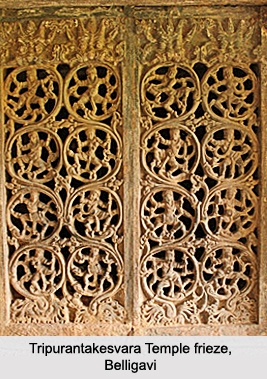 The features of Western Chalukya sculptures include the figure sculptures that have been used on the niches of the temple walls. While reflecting the artistic wizardry these figure sculptures also depict the religious beliefs of the people. Such sculptures from the Western Chalukya Empire are found on the pilasters, buildings, towers and sculptures.
The features of Western Chalukya sculptures include the figure sculptures that have been used on the niches of the temple walls. While reflecting the artistic wizardry these figure sculptures also depict the religious beliefs of the people. Such sculptures from the Western Chalukya Empire are found on the pilasters, buildings, towers and sculptures.
Figure sculptures are elaborately found on the friezes and panels. One of the distinct features of Western Chalukya sculptures is that the temples do not have events or heroes being depicted from the Hindu epics, Ramayana and Mahabharata in abundance. These were only found on some of the narrow friezes. The figure sculptures mainly comprise the miniature carvings of several gods and goddesses. Apart from these the sculptures of dancing girls are abundantly found on the recesses and nooks of the temple walls. Deities are also found on the lintels above the doorways. These lintels, in turn, are highly ornamented structures.
The norm of carving dancing girls in the niches and recesses of the walls became quite popular in the Western Chalukya or the Kalyani Empire. Apart from human forms animal figures were also depicted on the beams and cornices. Elephants and horses are the recurrent motifs, probably, because these animals were widely used.
Eroticism is also an important feature of the figure sculptures. This is evident in temples, such as, Tripurantakesvara Temple at Balligavi. Erotic figure sculptures are found on the narrow friezes.



